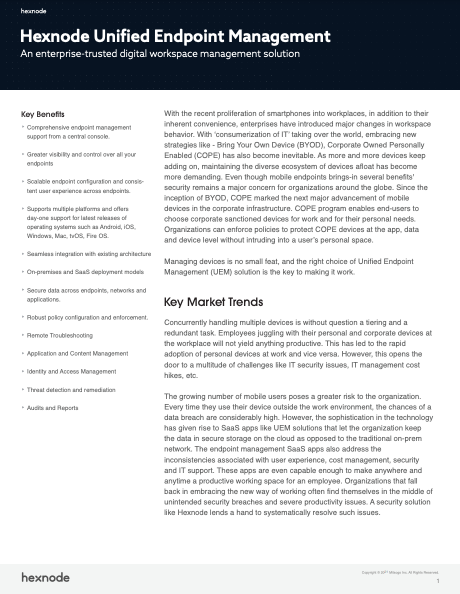Customizing device management policies with dynamic parameters
Dynamic parameters help in simplifying the policy association process by reducing the amount of manual work.

Get fresh insights, pro tips, and thought starters–only the best of posts for you.

The growing reliance on mobile devices and other smart devices has made device management a critical challenge for modern businesses. In this scenario, device management API provides a practical solution. They enable developers and system administrators to remotely manage and control a variety of devices.
Device management APIs provide a software interface that offers a framework for controlling and protecting devices, particularly in large-scale enterprise environments. These APIs allow administrators and developers to manage security and policies, deploy apps, monitor devices and enroll and provision devices remotely. So, let’s analyze the primary benefits of using device management APIs and how they help to simplify device management procedures, enhance security and improve overall business operations.
Device management APIs are a vital resource for developers who want to control and secure the devices that are used by their organizations. There are two main types of device management APIs: platform-specific APIs and cross-platform APIs. Let’s take a closer look at these two types:
Platform-specific APIs are designed for specific operating systems or device manufacturers. For example, Apple’s MDM APIs are optimized for managing iOS, iPadOS, macOS, and tvOS devices, whereas Android’s Device Administration APIs are tailored for managing only Android devices.
These APIs offer extensive access to device management features such as application deployment, device provisioning and security enforcement. The key benefits of using this platform-specific APIs include access to platform-specific features and capabilities, enhanced performance and tighter security.
Its main purpose is to simplify and speed up the app development process. Therefore, it provide developers a set of pre-built tools and resources that you can quickly incorporate into their apps. This can help to reduce development time and costs, while also ensuring that the resulting apps are of high quality and work effectively on the target platform.
Cross-platform APIs are made to work across different operating systems, allowing developers to protect and control devices from a single console. Google’s Firebase API is an example of cross-platform APIs that can be used to develop apps that work seamlessly across multiple platforms.
These APIs give device management a consistent approach, making it simple for developers to distribute applications and control devices on various platforms. Moreover, cross-platform APIs provide capabilities like analytics and push notifications that can assist developers in keeping track of app performance and interacting with users across several platforms.
So, which type of device management API should you use? The answer depends on your specific needs and use cases.In short, for controlling and safeguarding the devices used by modern enterprises, both platform-specific APIs and cross-platform APIs are crucial. So, whether you’re an IT admin or a developer, choosing the right device management API can help you build a safe and effective environment for the devices in your organization.
Data Privacy and Data Security: the connection and distinction

Get started with Hexnode’s Unified Endpoint Management solution to manage all your endpoints from a central console.
Download datasheetDevice management APIs provide a flexible framework for managing and controlling devices. It allows developers to create custom solutions that meet their specific needs. Some of the main features of device management APIs are as follows:
By automating the enrollment and provisioning of devices, device management APIs can make the process of setting up new devices quicker and more effective. This can include tasks like configuring settings, installing software and applications. Additionally, this will ensure that the device is set up to comply with organizational policies and procedures.
Device management APIs enable developers to build remote device management and control features into their applications. This can involve functions like remote device wiping, remote lock and unlock and remote troubleshooting and support. Organizations can benefit from these capabilities by lowering the risk of data breaches and increasing the effectiveness of device management tasks.
Device management APIs can assist enterprises in enforcing security policies and procedures on devices. It protects them from online threats and prevents the vulnerability of sensitive data. This can involve managing encryption settings and passwords, enforcing access rules and keeping an eye out for unauthorized access or usage.
Device management APIs can also enable developers to build app management and deployment capabilities into their applications. This can include tasks like managing app inventory, deploying new apps and ensuring that all apps are up-to-date and secure. These features can help organizations ensure that their employees have access to the tools and applications they need to be productive, while also maintaining security and compliance.
Device management APIs also facilitate integration with other enterprise systems, such as enterprise resource planning (ERP) and customer relationship management (CRM) platforms, allowing for a more comprehensive and streamlined approach to device management. This can result in significant cost savings and improved efficiency across the organization.
Overall, device management APIs are a powerful tool for businesses seeking to manage their devices more effectively, efficiently, and securely. As the demand for mobile devices and remote work continues to grow, the importance of device management APIs will only increase, making them a critical component of any modern IT strategy.
The Hexnode API is a RESTful API that supports the JSON, XML, and CSV file types. It gives developers access to a variety of device administration functions. It includes device enrollment and provisioning, remote device management and control, security and policy management and app management and deployment.
By leveraging the power of the Hexnode API, IT admins can streamline their workflows. This reduces the manual effort and free up time to focus on more critical tasks. Moreover, the API can be used to create custom workflows that fit specific business needs. This will allow the organizations to tailor their device management processes to their unique requirements.
The Hexnode API provides a versatile solution with numerous applications across different industries, including healthcare, education, retail and hospitality. By utilizing the capabilities of this API, organizations can optimize their device management systems. This will improve their overall IT operations, regardless of their industry or specific needs.
Hexnode API also provides developers with readily available building blocks that eliminate the need to start from scratch. Its RESTful JSON implementation allows to perform read, write, edit and delete operations. You can directly establish communication between the API and the developer using an HTTP client library. Therefore, by providing a simplified process, Hexnode API enables developers to focus on creating innovative solutions for device management.
Device management APIs provide developers a way to integrate their applications with MDM/UEM solutions. This gives them more flexibility and control over managing devices. Device management APIs offer a more granular level of control over specific devices and applications. On the other hand, MDM/UEM systems provide a comprehensive solution for managing devices. This can be especially helpful when organizations have certain needs or workflows that aren’t supported by pre-built MDM/UEM solutions. Moreover, this assists in automating operations, saving time and effort for IT admins.
Device management APIs enable businesses to stay up to date with the latest technology trends and innovations. It also provides a flexible and customizable approach to device management. This is especially important in today’s rapidly evolving digital landscape, where businesses must constantly adapt to stay competitive. By making an informed choice, businesses can position themselves ahead of the curve and enjoy successful device management. So, best of luck with your device management endeavors! Buh-bye👋🏻
Sign up for a 14-day free trial and explore Hexnode UEM's device management capabilities.
SIGN UP NOW!